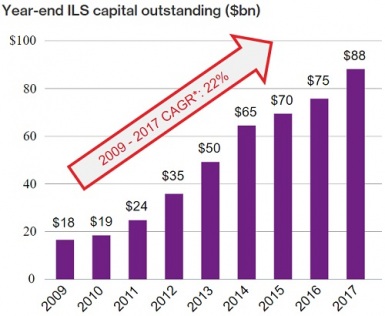
2018 is set to be another year of growth for insurance linked securities (ILS) as the market recovers from recent natural disasters, replaces lost capital and investors show mounting interest in ILS products. These are the findings of the latest quarterly ILS market update, from Willis Towers Watson Securities.
2017 was a record setting year for the ILS market as non-life ILS issuance continued to increase and ended the year close to $10 billion. It is estimated that non-life ILS capital stood at $88 billion at year end 2017, which represents a year-on-year increase of 17% from $75 billion in 2016.
According to the report, this demonstrates that the ILS market was able to withstand the 2017 natural catastrophe losses as funds diligently reached out to their investors and risk partners ensuring an orderly and supportive environment. It also shows that ILS capital is looking to both the short-term potential for modestly better risk spreads and the longer-term opportunity to partner with reinsurers, insurers and insureds to fuel AUM growth and ultimately make insurance more available and affordable.
The fourth quarter of 2017 saw considerable loss activity across all ILS investments with a preliminary estimate of $630 million in cat bond principal losses including hurricane, earthquake, and wildfire activity. It also saw $1.3 billion of non-life catastrophe bond capacity issued through five cat bonds. Covea Mutual Insurance Group and Validus Holdings represented two new sponsors with Hexagon Re and Tailwind Re 2017-1.
Bill Dubinsky, Managing Director and head of ILS, Willis Towers Watson Securities, said: “We see no end in sight to ILS growth. The ILS community is signalling that it is ready and open for business. 2018 is shaping up as a brutal battle for market share between, on the one hand, incumbent reinsurers and ILS investors trying to both maintain their positions and exact some rate increases and, on the other hand, other ILS investors and reinsurers trying to stake a claim to participate in additional risk.”

